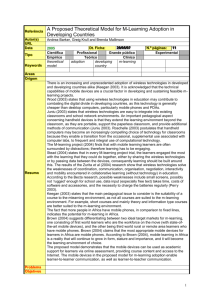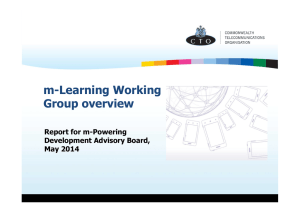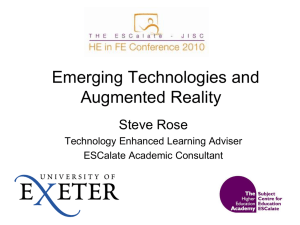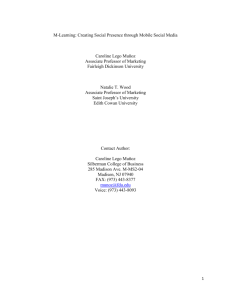International Journal of Application or Innovation in Engineering & Management... Web Site: www.ijaiem.org Email: ISSN 2319 – 4847
advertisement
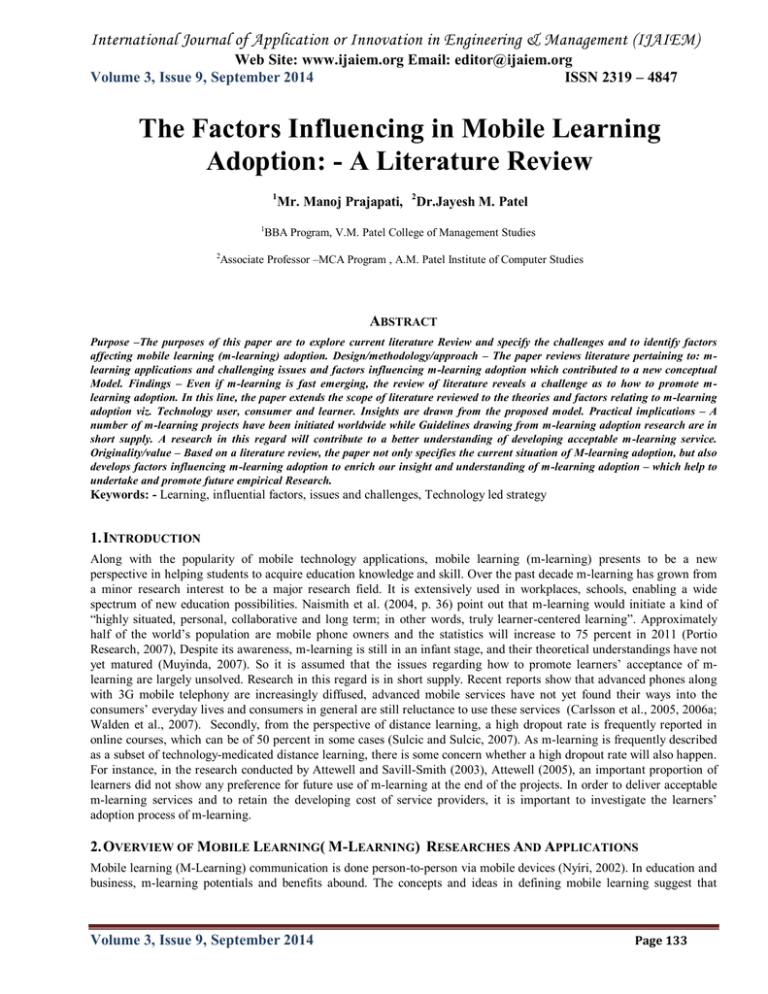
International Journal of Application or Innovation in Engineering & Management (IJAIEM) Web Site: www.ijaiem.org Email: editor@ijaiem.org Volume 3, Issue 9, September 2014 ISSN 2319 – 4847 The Factors Influencing in Mobile Learning Adoption: - A Literature Review 1 Mr. Manoj Prajapati, 2Dr.Jayesh M. Patel 1 BBA Program, V.M. Patel College of Management Studies 2 Associate Professor –MCA Program , A.M. Patel Institute of Computer Studies ABSTRACT Purpose –The purposes of this paper are to explore current literature Review and specify the challenges and to identify factors affecting mobile learning (m-learning) adoption. Design/methodology/approach – The paper reviews literature pertaining to: mlearning applications and challenging issues and factors influencing m-learning adoption which contributed to a new conceptual Model. Findings – Even if m-learning is fast emerging, the review of literature reveals a challenge as to how to promote mlearning adoption. In this line, the paper extends the scope of literature reviewed to the theories and factors relating to m-learning adoption viz. Technology user, consumer and learner. Insights are drawn from the proposed model. Practical implications – A number of m-learning projects have been initiated worldwide while Guidelines drawing from m-learning adoption research are in short supply. A research in this regard will contribute to a better understanding of developing acceptable m-learning service. Originality/value – Based on a literature review, the paper not only specifies the current situation of M-learning adoption, but also develops factors influencing m-learning adoption to enrich our insight and understanding of m-learning adoption – which help to undertake and promote future empirical Research. Keywords: - Learning, influential factors, issues and challenges, Technology led strategy 1. INTRODUCTION Along with the popularity of mobile technology applications, mobile learning (m-learning) presents to be a new perspective in helping students to acquire education knowledge and skill. Over the past decade m-learning has grown from a minor research interest to be a major research field. It is extensively used in workplaces, schools, enabling a wide spectrum of new education possibilities. Naismith et al. (2004, p. 36) point out that m-learning would initiate a kind of “highly situated, personal, collaborative and long term; in other words, truly learner-centered learning”. Approximately half of the world’s population are mobile phone owners and the statistics will increase to 75 percent in 2011 (Portio Research, 2007), Despite its awareness, m-learning is still in an infant stage, and their theoretical understandings have not yet matured (Muyinda, 2007). So it is assumed that the issues regarding how to promote learners’ acceptance of mlearning are largely unsolved. Research in this regard is in short supply. Recent reports show that advanced phones along with 3G mobile telephony are increasingly diffused, advanced mobile services have not yet found their ways into the consumers’ everyday lives and consumers in general are still reluctance to use these services (Carlsson et al., 2005, 2006a; Walden et al., 2007). Secondly, from the perspective of distance learning, a high dropout rate is frequently reported in online courses, which can be of 50 percent in some cases (Sulcic and Sulcic, 2007). As m-learning is frequently described as a subset of technology-medicated distance learning, there is some concern whether a high dropout rate will also happen. For instance, in the research conducted by Attewell and Savill-Smith (2003), Attewell (2005), an important proportion of learners did not show any preference for future use of m-learning at the end of the projects. In order to deliver acceptable m-learning services and to retain the developing cost of service providers, it is important to investigate the learners’ adoption process of m-learning. 2. OVERVIEW OF MOBILE LEARNING( M-LEARNING) RESEARCHES AND APPLICATIONS Mobile learning (M-Learning) communication is done person-to-person via mobile devices (Nyíri, 2002). In education and business, m-learning potentials and benefits abound. The concepts and ideas in defining mobile learning suggest that Volume 3, Issue 9, September 2014 Page 133 International Journal of Application or Innovation in Engineering & Management (IJAIEM) Web Site: www.ijaiem.org Email: editor@ijaiem.org Volume 3, Issue 9, September 2014 ISSN 2319 – 4847 learners’ mobility, learning virtually anywhere and anytime, via mobile devices, are the main characteristics of mobile learning. Research on the teaching and learning through mobile learning has become a rapidly evolving area (Preece, 2000; Frohberg, 2002; Vavoula, Pachler and Kukulska-Hulme, 2009). In addition to common students, learners “who were hard to reach, and hard to engage, or hard to access – for example young offenders, traveler communities, disengaged teenagers and work-based learners in difficult contexts” appears to be a hot topic for m-learning research (Attewell, 2005; Stead, 2006, p. 1; Duncan-Howell and Lee, 2007). Funded by the European Commission, a pan-European project – mlearning for instance has been run since 2001 for educationally disadvantaged young adults, such as dropouts and unemployed, to improve their literacy and numeracy skills. Further, m-learning in many countries has been developed to be a sort of new education products, generating new sources of revenue for business communities. From a technology viewpoint, many scholars state that there are many technical restrictions that may impede m-learning adoption. Wang et al. (2009) note that technical challenges make the adaptation of existing e-learning services to m-learning difficult, and that users may not be inclined to accept m-learning. 3. FACTOR INFLUENCING IN M-LEARNING ADOPTIONS Functional The devices can provide instant and spontaneous information (Cavus and Ibrahim, 2009; Eteokleous and Ktoridou, 2009; Cohen, 2010). There are times when learners really need to get certain information fast. For example, quick answers to specific questions as definitions, formula and equation. The devices will help the learners to quickly search such information. Continuity is another functional aspect. Mobile learning is a learning model that allows the learners to gain learning materials anywhere and anytime. To be able to continue with the learning without the constraints of time and location is an important element that affects how learners may be motivated to use their mobile applications (Lan and Sie, 2010). Learners’ access to information and learning material does not necessarily stop because of their location. Indeed learners can access and interact at various places and in a variety of situations. User as a consumer M-learning users therefore gain a role as consumers as well. For customers perceived quality of products or services impacts customer’s intentions to use them. Perceived quality is defined by Zeithaml (1988) as “the consumer’s judgment about a product’s overall excellence or superiority”. Quality research tends to be most important stream of services research. Specifically, many researches tend to divide perceived quality into different dimensions regarding different research subjects (Parasuraman et al., 1985, 1988), due to the fact that perceived quality is product-related (Chu and Lu, 2007). Concerning IS, a number of scholars suggest that the quality of both technology infrastructure and service delivered would impact perceived overall quality, which further affects users’ acceptance intention. Delone and McLean (1992) propose the notion of information quality and suggest that information quality plays an important role in building successful ISs. Cheong and Park (2005) show that perceived system quality and perceived content quality are positively related to users’ perceived usefulness of the mobile internet. Lin and Lu (2000) employ information quality as a part of IS quality, and argue that information quality is an important determinant of perceived usefulness. From a knowledge management viewpoint, Dai et al. (2007) suggest that content quality is one of the significant determinants of perceived usefulness of online social information services. Further, many scholars tend to study perceived quality of IS in a global view. Yang et al. (2005) outline six dimensions of quality and further find a positive causal relationship between the perceived overall service quality and a user’s satisfaction towards a web portable. Measuring both the system issues and content issues, Chiu et al. (2005) and Liaw (2008) found that perceived quality is a significant predictor of perceived satisfaction with e-learning. Since m-learning can also be perceived as a kind of advanced information. service, it stands to reason to use perceived quality as an important component of model. Also, based on prior studies, the quality perceived in our research model includes both two dimensions: perceived content quality and perceived system quality. Social Influence Social Influence (SF) is the extent to which users perceive that others important to them believe that they should use a new information system. UTAUT uses three constructs from existing models to capture the concept of Social Influence: subjective norm (TRA, TAM2, TPB and C-TAM-TPB), social factors (MPCU) and image (IDT) . In the context of Mlearning, there are many effects of Social Influence (e.g. ecturers, instructors, parents, peers, etc.). All of these social factors will strongly affect students' Intention to use M-learning in the pedagogical environment. Shows that Effort Expectancy has a significant positive relationship with Behavioral Intention (BI).Furthermore use UTAUT to examine acceptance of e-government services. Findings show that peer influence for students is more significant in situations where they have limited experience with an information system (e.g. Mobile devices). The researchers highlight the importance Volume 3, Issue 9, September 2014 Page 134 International Journal of Application or Innovation in Engineering & Management (IJAIEM) Web Site: www.ijaiem.org Email: editor@ijaiem.org Volume 3, Issue 9, September 2014 ISSN 2319 – 4847 of ensuring positive experiences with an information system since users may be influenced by their peers or those considered important to them Self Management Learning Self-management of Learning is questionable as a determinant in this study. The more the learner controls their own activities, the more successful learning will occur Classroom learning will guide the students learning but when the student moves out of this context the literature evokes that Self-management of Learning is important to a student's success. Selfmanagement of Learning refers to "the degree to which an individual perceives self-discipline and can engage in autonomous learning" Successful Self-management of Learning comes as a result of developing competence and skill in learning how to learn Thus,concludes that the skill of self-directed learning is essential for effective engagement with flexible delivery and resource-based learning. In the context of M-learning students must be the managers of their own learning because they are away from faculty, peers, and the institutional support. Self-management of Learning has been found to play a critical role in predicting Mlearning In the same study, it was also unexpectedly found that Selfmanagement of Learning is a stronger determinant for women than for men. Therefore Self-management of Learning in this study has been assumed to have significant impact on students' Intention to use M-learning in higher education. Experiential Learning(Learning in Context) The mobility of the devices allow for learning which is not constrained to the educational environments. The tools develop the connection between school and other everyday activities (Sharples, 2003). This gives the notion that education can go beyond the classroom context and ‘things’ that are relevant to the learning itself can be brought into the classroom and the different aspects of the visit can be enhanced for purposes of learning (Chen, Kao, Sheu and Chiang, 2002; Lonsdale, Baber, Sharples, Byrne, Arvanitis, Brundell and Beale, 2004). Problem Based Learning KNOWMOBILE project in Norway (Smørdal and Gregory, 2005) is one example that mobile learning supports Problem-Based Learning. PDAs and smart-phones were used for experiment in medical education of students from the School of Medicine at University of Oslo. In problem-based learning, the learners actively discover and work with content that they determine to be necessary to solve the problem given by the teacher. 4. CHALLENGES AND ISSUES Numerous issues and challenges may undoubtedly appear in adopting mobile learning practice. From the literature undertaken for this paper, the researchers analysed and synthesized the issues and challenges based on the same classification as the influential factors. Most issues and challenges are very much related to the features of mobile devices and a few regarding user’s expectations, However, in pedagogical issues, especially the academic and context specific which is referring to how sound the applications are in terms of their pedagogical and learning content issues (Muir, Shield and Kukulska-Hulme, 2003), the researchers are yet to look for more literature. The gap here is not because there is no issue exist regarding the teaching and learning through mobile learning but rather because there is a lack of in-depth studies on these aspects. Usability The first issue of usability is the small screen size. The current mobile devices are designed with the focus to allow users to enter and access structured data like contacts, lists, dates, financial information, and memos, to send and receive messages, to view documents and pictures, or to access the web (Kukulska-Hulme, 2005). A study on using a PDA for learning purposes revealed difficulties in reading due to the poor screen display (Trinder, Magill and Roy, 2005). The small, touchsensitive screens of smartphones can pose problems in navigating the screen with fingers and learners may accidently select a function such as deleting a document. Secondly, the cognitive and ergonomic issue (Kukulska-Hulme and Traxler, 2005) which is related to the conceptions of differences between using PCs and mobile devices, print material and electronic small size depictions of large texts. Ergonomic issues include the fear of deleting diary entries from the device. Technical There are several technical issues. First is the connectivity issue that refers to the issues of connectivity in certain places, and issues of intuitive integration between the hardware and the software of the device (i.e., the mouse wheel, soft keys, etc) (Nielsen, 2003). A study indicated that the respondents had problem with PDAs because of slow transmission (Smørdal, Gregory and Langseth, 2002). They also emphasized that the e-book material that was made available was not useful, nor was the use of messaging services for collaborative learning. Besides, they also experienced problems working across different applications. Secondly, the life of the batteries in which downloading educational applications and games uses up batteries much quicker especially when using free apps (Morg, 2012). Studies discovered that the battery’s energy continues to be drained even after the downloading of information has completed Volume 3, Issue 9, September 2014 Page 135 International Journal of Application or Innovation in Engineering & Management (IJAIEM) Web Site: www.ijaiem.org Email: editor@ijaiem.org Volume 3, Issue 9, September 2014 ISSN 2319 – 4847 5. CONCLUSION Study in depth about the potential aspect of M-learning is necessary because M-learning still in its initial stage. Before adopting mobile learning into the mainstream education, careful considerations have to be placed on issues that arise. The overall view of the existing research work and projects in the mobile learning domains suggest that critical attentions should be paid to the outcomes of the many projects academically, how they are measured and assessed in order to ascertain the soundness of the knowledge gained and the aptness of the learning tools used. However, it is a challenge to apply traditional adoption models in an m-learning context. For instance, Carlsson et al. (2006b, p. 8) argue that, TAM and unified theory of acceptance and use of technology (UTAUT) were developed to describe and explain IT innovation adoption in organizational contexts, “but the mobile technology adoption is more individual, more personalized and focused on the services made available by the technology”. It contributes to the growing literature on m-learning by grounding new theories and variables into well-established model (TAM) and applying them to a new context of mlearning. It fills a gap by extending TAM to social contexts when technology user gains a new role – learner. This in turn would offer a set of possible guidelines for practitioners to promote the diffusion of m-learning [This Model Has been Adopted from ” Understanding the factors driving m-learning adoption: a literature review Yong Liu and Shengnan Han A ° bo Akademi University, Turku, Finland, and Hongxiu Li A bo Akademi University, Turku, Finland and Information Systems Science Institute, School of Economics, University of Turku, Turku, Finland”] In addition, as mobile technologies and devices are used as a conduit to transmit training and education to the learner, the quality of learning materials delivered would affect the perceived quality of services as a whole. Hence, it is essential to increase the relevancy, timeliness, adequacy, and uniqueness of learning materials that are delivered. The proposed model provides a coherent framework for further empirical research. An empirical testing of the conceptual model would extend the boundaries of current theoretical foundations, and enrich our understanding of m-learning. REFERENCES [1] AlAwadhi, S. and A. Morris (2008). The Use of the UTAUT Model in the Adoptionof E-government Services in Kuwait. Proceedings of the 41st HawaiiInternational Conference on System Sciences. [2] Ali Yaslam Almatari1, Noorminshah A.Iahad2, Ali Saleh Balaid3 “Factors Influencing Students' Intention to Use Mlearning” Faculty of Computing, Universiti Teknologi Malaysia, 81310, Skudai, Johor, Malaysia JOURNAL OF INFORMATION SYSTEMS RESEARCH AND INNOVATION http://seminar.utmspace.edu.my/jisri/ [3] Attewell, J. (2005), Mobile Technologies and Learning: A Technology Update and M-learning Project Summary, Learning and Skills Development Agency, London. [4] Attewell, J. and Savill-Smith, C. (2003), “Mobile learning and social inclusion: focusing on [5] learners and learning”, MLEARN 2003 Conference – Learning with Mobile Devices, London, UK, pp. 3-11. [6] Attewell, J., & Webster, T. (2005). Engaging and Supporting Mobile Learners. Mobile learning anytime everywhere: A book of papers from mLearn 2004, London: LSDA, 15-19. [7] Carlsson, C., Carlsson, J., Hyvo¨nen, K., Puhakainen, J. and Walden, P. (2006b), “Adoption of mobile devices/services – searching for answers with the UTAUT”, Proceedings of the 39th Annual Hawaii International Conference on System Sciences (HICSS’06), Track 6, p. 132a. [8] Carlsson, C., Carlsson, J., Puhakainen, J. and Walden, P. (2006a), “Nice mobile services do not fly. Observations of mobile services and the Finnish consumers”, Proceedings of the 19th Bled eCommerce Conference, Bled, Slovenia. Volume 3, Issue 9, September 2014 Page 136 International Journal of Application or Innovation in Engineering & Management (IJAIEM) Web Site: www.ijaiem.org Email: editor@ijaiem.org Volume 3, Issue 9, September 2014 ISSN 2319 – 4847 [9] Carlsson, C., Hyvonen, K., Repo, P. and Walden, P. (2005), “Asynchronous adoption patterns of mobile services”, in Sprague Ralph, H. (Ed.), Proceedings of the 38th Annual Hawaii M-learning adoption 221 International Conference on System Sciences, IEEE Computer Society Press, Los Alamitos, CA [10] Cavus, N., & Ibrahim, D. (2009). M-learning: an experiment in using SMS to support learning new English language words. British Journal of Educational Technology, 40(1), 78-91. [11] Chen, Y.S., Kao, T.C., Sheu, J.P., & Chiang, C.Y. (2002). A Mobile Scaffolding-Aid-Based Bird - Watching Learning System. Proceedings of IEEE International Workshop on Wireless and Mobile Technologies in Education (WMTE'02), pp.15-22. [12] Cheong, J.H. and Park, M.C. (2005), “Mobile internet acceptance in Korea”, Internet Research, Vol. 15 No. 2, pp. 125-40. [13] Chiu, C.M., Hsu, M., Sun, S.-Y., Lin, T. and Sun, P.-C. (2005), “Usability, quality, value and e-learning continuance decisions”, Computer & Education, Vol. 45 No. 4, pp. 399-416. [14] Chu, C.W. and Lu, H.P. (2007), “Factors influencing online music purchase intention in Taiwan: an empirical study based on the value-intention framework”, Internet Research, Vol. 17 No. 2, pp. 139-55. [15] Cohen, A. (2010). Characteristics of effective mobile learning. Retrieved June 2, 2011, from [16] http://www.brainscape.com/blog/2010/09/characteristics-of-effective-mobile-learning/ [17] Dai, Y.S., Gao, Q., Fan, Z. and Kang, R. (2007), “User perceived quality of online social information services: from the perspective of knowledge management”, Proceedings of the 2007 IEEE IEEM, Singapore, pp. 482-6 [18] Delone, H. and McLean, R. (1992), “Information system success: the quest for the dependent variable”, Information Systems Research, Vol. 3 No. 1, pp. 60-95. [19] Duncan-Howell, J. and Lee, K.T. (2007), “M-learning: finding a place for mobile technologies within tertiary educational settings”, ICT: Providing Choices for Learners and Learning, Proceedings Ascilite Singapore [20] Eteokleous, N., & Ktoridou, D. (2009). Investigating mobile devices integration in higher education in Cyprus: faculty perspectives. International Journal of Interactive Mobile Technologies, 3(1), 38-48. [21] Frohberg, D. (2002). Communities- the MOBIlearn perspective. Retrieved October 10, 2012 from http://www.idi.ntnu.no/~divitini/umocec2003/Final/frohberg.pdf [22] Jairak, K., Praneetpolgrang, P. et al. (2009). "An Acceptance of M-learning for Higher Education Students in Thailand." The Sixth International Conference on eLearning for Knowledge-Based Society 17-18. [23] Kukulska-Hulme, A. (2005). Mobile usability and user experience. In A. Kukulska Hulme & J. Traxler (Eds.), Mobile Learning: A handbook for educators and trainers (pp. 45-46). London: Routledge. [24] Kukulska-Hulme, A., & Traxler, J. (eds.) 2005. Mobile learning. A handbook for educators and trainers. Open and flexible learning series, Routledge, London. [25] Lan, Y. F., & Sie, Y. S. (2010). Using RSS to support mobile learning based on media richness theory. Computers & Education, 55(2), 723- 732. [26] Liaw, S.S. (2008), “Investigating students’ perceived satisfaction, behavioral intention, and effectiveness of elearning: a case study of the Blackboard system”, Computers & Education, Vol. 51 No. 2, pp. 864-73. [27] Lonsdale, P., Baber, C., Sharples, M., Byrne, W., Arvanitis, T., Brundell, P., and Beale, H. (2004). Context awareness for MOBIlearn: creating an engaging learning experience in an art museum. Proceedings of MLEARN 2004. Bracciano, Rome: LSDA. [28] Morg, T. (2012). Batteries on mobile devices drained more quickly by apps which are free, research says. Retrieved on October 10, 2012, from http://www.digitaltrends.com/mobile/batteries-on-mobile-devices-drained-more-quickly-byapps-which-are-free-researchsays/# ixzz28IUWPv7m [29] Muir, A., Shield, L., & Kukulska-Hulme, A. (2003). The pyramid of usability: A framework for quality course websites. Proceedings of EDEN 12th Annual Conference of the European Distance Education Network, The Quality Dialogue: Integrating Quality Cultures in Flexible, Distance and eLearning, Rhodes, Greece, 15-18 June 2003, 188194. [30] Muyinda, P.B. (2007), “MLearning: pedagogical, technical and organizational hypes and [31] realities”, Campus-Wide Information Systems, Vol. 24 No. 2, pp. 97-104. [32] Naismith, L., Peter, L., Giasemi, V. and Sharples, M. (2004), Literature Review in Mobile Technologies and Learning, Futurelab, Bristol. [33] Nielsen, J. (2003). Mobile devices: One generation from useful. Retrieved August 2012 from http://www.useit.com/alertbox/20030818.html Volume 3, Issue 9, September 2014 Page 137 International Journal of Application or Innovation in Engineering & Management (IJAIEM) Web Site: www.ijaiem.org Email: editor@ijaiem.org Volume 3, Issue 9, September 2014 ISSN 2319 – 4847 [34] Nyíri, K. (2002). Towards a philosophy of M-Learning. Paper presented at the IEEE International Workshop on Wireless and Mobile Technologies in Education (WMTE 2002), August 29-30, 2002, Teleborg Campus, Växjö University, Växjö, Sweden. [35] Parasuraman, A., Zeithaml, V. and Berry, L. (1985), “A conceptual model of service quality [36] and its implications for future research”, Journal of Marketing, Vol. 49 No. 4, pp. 41-50. [37] Parasuraman, A., Zeithaml, V. and Berry, L. (1988), “SERVQUAL: a multi-item scale for measuring consumer perceptions of service quality”, Journal of Retailing, Vol. 64 No. 1, pp. 12-40. [38] Portio Research (2007), “Worldwide mobile penetration will reach 75% by 2011”, available at: www.portioresearch.com/next_billion_press.html (accessed 23 March 2008). [39] Preece, J. (2000). Online communities: designing usability, supporting sociability. Chichester:Wiley [40] Ravenscroft, A. (2000). "Designing argumentation for conceptual development."Computers and Education 34(241255). [41] Samsiah Bidin ,Azidah Abu Ziden ” Adoption and application of mobile learning in the education Industry” 6th International Conference on University Learning and Teaching (InCULT 2012) Procedia - Social and Behavioral Sciences 90 ( 2013 ) 720 – 729 [42] Sharples, M. (2003). Disruptive devices: mobile technology for conversational learning.International Journal of Continuing Engineering Education and Lifelong Learning, 12(5/6), 504-520. [43] Sharples, M. (2003). Disruptive devices: mobile technology for conversational learning. International Journal of Continuing Engineering Education and Lifelong Learning, 12(5/6), 504–520. [44] Smith, P. J., Murphy, K. L. et al. (2003). "Towards Identifying Factors Underlying Readiness for Online Learning: An Exploratory Study." Distance Education 24(1) 57–67. [45] Smørdal, O., & Gregory, J. (2005). KNOWMOBILE: mobile opportunities for medical students. In A. KukulskaHulme & J. Traxler (Eds.), Mobile learning: A handbook for educators and trainers (pp. 99-105). London: Routledge. [46] Smørdal, O., Gregory, J., & Langseth, K.J. (2002): PDAs in Medical Education and Practice. Proceeding of IEEE International Workshop on Wireless and Mobile Technologies in Education (WMTE 2002), (p. 140-146), Växjö, Sweden, August 2002 [47] Stead, G. (2006), Mobile Technologies: Transforming the Future of Learning, Emerging Technologies for Learning, British Educational Communications and Technology Agency, ICT Research, Coventry, pp. 6-15. [48] Sulcic, V. and Sulcic, A. (2007), “Can online tutors improve the quality of e-learning?”, Informing Science and Information Technology, Vol. 4, pp. 201-10. [49] Trinder, J., Magill, J., & Roy, S. (2005). Expect the unexpected: Practicalities and problems of a PDA project. In A. Kukulska-Hulme & J. Traxler (Eds.). Mobile learning: A handbook for educators and trainers (pp. 92-8). London: Routledge. [50] Vavoula, G., Pachler, N., & Kukulska-Hulme, A. (2009). Researching mobile learning: frameworks,tools and research designs. Oxford, UK: Peter Lang. [51] Venkatesh, V., Smith, R. H. et al. (2003). "user acceptance of information technology: toward a unified view1." Mis quarterly 27(3): 425-478. [52] Walden, P., Han, S., Carlsson, C. and Majlender, P. (2007), “The sleeping giant – a longitudinal study surveying the mobile service market in Finland”, Proceedings of the 15th European Conference on Information Systems, University of St Gallen, St Gallen, Switzerland, pp. 1885-95. [53] Wang, Y.-S. and Shih Y.-W. (2009). "Why do people use information kiosks? A validation of the Unified Theory of Acceptance and Use of Technology." Government Information Quarterly 26: 158-165. [54] Wang, Y.-S., Wu, M.-C. et al. (2009). "Investigating the determinants and age and gender differences in the acceptance of M-learning." British Journal of Educational Technology 40(1): 92-118 [55] Yang, Z., Cai, S., Zhou, Z. and Zhou, N. (2005), “Development and validation of an instrument to measure user perceived service quality of information presenting web portals”, Information & Management, Vol. 42 No. 4, pp. 57589. [56] Yong Liu and Shengnan Han, Hongxiu Li “Understanding the factors driving m-learning adoption: a literature review” Campus-Wide Information Systems Vol. 27 No. 4, 2010 pp. 210-226 q Emerald Group Publishing Limited 1065-0741 DOI 10.1108/10650741011073761 [57] Zeithaml, V.A. (1988), “Consumer perceptions of price, quality, and value: a means-end model and synthesis of evidence”, Journal of Marketing, Vol. 52, pp. 2-22. Volume 3, Issue 9, September 2014 Page 138

